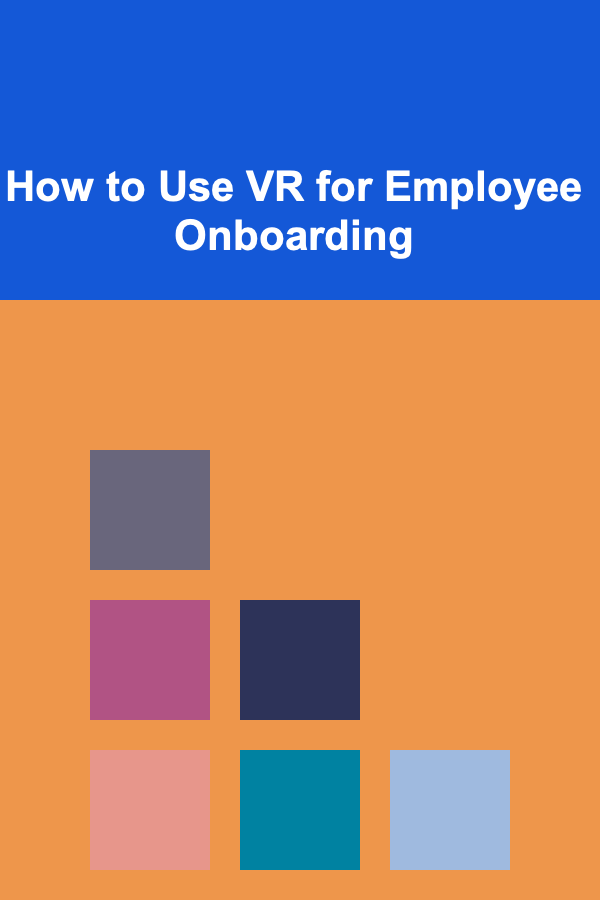
How to Use VR for Employee Onboarding
ebook include PDF & Audio bundle (Micro Guide)
$12.99$6.99
Limited Time Offer! Order within the next:

Employee onboarding is a critical phase in the lifecycle of an employee's journey with a company. It is the first step in integrating new hires into the company culture, operations, and systems. Traditional onboarding often relies on paper-based documents, face-to-face meetings, and PowerPoint presentations, but these methods can be inefficient, time-consuming, and not particularly engaging. In recent years, Virtual Reality (VR) has emerged as a game-changer for employee onboarding. By immersing new employees in a simulated, interactive environment, VR allows them to experience the workplace in a more engaging and memorable way.
In this article, we will explore how companies can effectively use VR for employee onboarding, the benefits it offers, challenges to consider, and how it can be implemented to improve the onboarding experience.
The Evolution of Employee Onboarding
Traditional employee onboarding processes typically involve introductions to the team, briefings about company policies, training sessions on job-specific tasks, and familiarization with office spaces. Although essential, these methods can often lack interactivity and fail to capture the full attention of the new hires. In many cases, employees find the process overwhelming or disengaging, which can lead to confusion, slower adjustment times, and even early attrition.
With technological advancements, the onboarding experience has evolved to incorporate digital tools that can enhance learning and engagement. Online training modules, videos, and eLearning platforms are now common, but they often still fall short in delivering hands-on experiences. Virtual Reality, on the other hand, provides a level of immersion that other digital tools cannot. By using VR, employers can simulate real-world scenarios in a way that feels both safe and effective for new employees to practice and learn.
What Is Virtual Reality?
Virtual Reality refers to a computer-generated environment that simulates a physical presence in a real or imagined world. By using specialized equipment such as VR headsets, controllers, and motion tracking systems, users can interact with the virtual environment as though they are physically present. VR can replicate everything from a simple office tour to more complex, scenario-based training exercises.
While VR has been used in industries such as gaming, entertainment, and healthcare for years, its application in business and human resources, particularly in onboarding, is relatively new. However, its potential to revolutionize employee onboarding is immense, offering opportunities for better engagement, faster learning, and improved retention of company information.
How VR Enhances Employee Onboarding
1. Immersive Learning Experience
Traditional onboarding methods such as lectures, videos, or reading materials can struggle to keep new hires engaged. VR, however, offers a fully immersive experience that makes learning more memorable. New employees can explore the office, practice tasks in a simulated environment, and receive feedback in real-time, all of which help to reinforce learning.
For example, VR onboarding could include virtual simulations of common workplace scenarios, such as interacting with customers, navigating company systems, or responding to emergency situations. This allows employees to engage with real-life challenges in a safe, controlled environment, enhancing both their understanding and confidence.
2. Reduces Training Time
In traditional onboarding programs, employees may spend days or weeks learning how to navigate office systems or perform certain tasks. With VR, however, training can be compressed into more focused, efficient sessions. Employees can repeatedly practice tasks or processes in a virtual environment, enabling them to learn faster and retain more information.
For instance, instead of spending hours shadowing a colleague or attending lengthy training sessions, employees can quickly immerse themselves in a virtual training session that teaches them how to use the company's software, perform their tasks, or follow safety procedures. This reduces the time it takes to get employees up to speed and allows them to become productive sooner.
3. Consistency Across the Board
One of the challenges with traditional onboarding is ensuring that all new hires receive the same training, which can vary depending on the trainer or the environment. Inconsistent onboarding can result in confusion and hinder the employee's understanding of the role or company culture.
By using VR, employers can ensure that all new hires receive the same training experience, regardless of their location or the trainer's experience. A virtual environment offers uniformity, as every employee will be exposed to the same simulations, scenarios, and feedback. This creates a standardized onboarding experience that can be measured and improved over time.
4. Flexibility and Remote Onboarding
One of the most significant advantages of VR in onboarding is the ability to provide flexibility. With the rise of remote work, employees may not always be physically present at the company's headquarters for their onboarding. VR allows employers to offer a remote onboarding experience that is just as immersive and informative as an in-person one.
For example, employees working from different locations can participate in a virtual office tour or interact with virtual colleagues from around the world. This flexibility makes VR a powerful tool for global companies looking to onboard employees regardless of their geographical location.
5. Safe and Risk-Free Training
In some industries, onboarding requires employees to practice high-risk tasks, such as operating machinery, handling hazardous materials, or providing customer service in challenging situations. These activities can be difficult, expensive, or dangerous to simulate in the real world. VR, however, allows companies to create risk-free environments where employees can practice these tasks without fear of making mistakes that could have real-world consequences.
For instance, VR can be used to simulate complex machinery operations or emergency response situations. Employees can practice operating equipment, responding to fire drills, or interacting with irate customers, all without any danger to themselves or others.
6. Improved Company Culture and Socialization
Onboarding isn't just about training employees for their tasks; it's also about helping them integrate into the company culture and form relationships with their colleagues. VR can create a more dynamic and social onboarding experience. For example, new employees can participate in virtual team-building exercises, attend social events in a virtual environment, or interact with colleagues in a more engaging manner.
Additionally, VR can allow employees to engage in scenarios where they learn company values and mission statements through immersive experiences, reinforcing the company culture. Socialization through VR allows remote employees to feel included in the team despite being geographically distant.
Implementing VR in Employee Onboarding
While VR can offer many benefits, implementing it effectively requires careful planning and execution. Below are the steps organizations can take to integrate VR into their onboarding programs.
1. Identify Training Needs
The first step in using VR for onboarding is to identify which aspects of the onboarding process will benefit most from an immersive experience. Consider tasks or scenarios that are complex, repetitive, or difficult to simulate in real life. Some examples include:
- Office tours and orientation
- Customer service simulations
- Software training
- Workplace safety drills
- Company values and culture immersion
2. Develop the VR Content
Once you have identified the training needs, you'll need to create the virtual environments or scenarios that will best meet those needs. Depending on your resources, you can either create custom VR content in-house, partner with a VR development company, or use off-the-shelf VR onboarding solutions. Developing high-quality VR content requires expertise in VR design, storytelling, and technology. It's essential to ensure the training scenarios are realistic, engaging, and relevant to the employees' roles.
3. Choose the Right VR Technology
To implement VR effectively, you need to choose the right hardware and software. This will depend on the complexity of your VR training and the scale at which you plan to deploy it. Common VR hardware includes:
- VR headsets (e.g., Oculus Quest, HTC Vive, or PlayStation VR)
- Motion controllers
- Hand-tracking systems
You'll also need a VR platform or software that allows you to create, manage, and deliver the VR training content. These platforms typically come with tools for creating interactive simulations, tracking employee progress, and gathering feedback.
4. Test and Pilot the Program
Before launching the VR onboarding program company-wide, it's essential to test it with a small group of employees. This allows you to gather feedback and make any necessary adjustments. During the pilot phase, pay attention to user experience, technical issues, and any challenges employees face while navigating the VR environment. Use the feedback to refine the training program and ensure it is effective and engaging.
5. Integrate VR into the Larger Onboarding Process
Once your VR onboarding program is ready, it should be integrated seamlessly into your overall onboarding process. Ensure that it complements other forms of training, such as in-person meetings, videos, and eLearning modules. VR should be seen as a tool to enhance, not replace, traditional onboarding methods.
6. Measure Success and Improve
Finally, it's important to measure the success of your VR onboarding program. Track employee performance during the VR training sessions, gather feedback from participants, and assess the impact of VR on employee engagement and retention. This data will help you refine and improve the program for future employees.
Challenges of Using VR for Employee Onboarding
While VR offers many advantages, there are also challenges to consider:
- Cost: VR hardware and software development can be expensive, particularly for smaller companies. However, the long-term benefits in terms of faster training, improved engagement, and reduced turnover may outweigh the initial investment.
- Technological Barriers: Not all employees may be familiar with VR technology, and some may experience motion sickness or discomfort while using VR headsets. It's essential to provide training on how to use VR and ensure the experience is user-friendly.
- Content Creation: Developing high-quality VR content that is engaging and effective can be time-consuming and require specialized expertise. Companies may need to invest in skilled designers or external developers to create their VR training modules.
- Adoption: Not all employees or managers may be comfortable with VR technology, and there may be resistance to change. Offering clear communication and demonstrating the benefits of VR onboarding can help alleviate concerns and encourage adoption.
Conclusion
Using VR for employee onboarding represents a bold step toward revolutionizing how new employees are integrated into a company. By providing immersive, engaging, and interactive training experiences, VR can reduce training time, improve employee retention, and ensure that all employees have a consistent and engaging onboarding experience.
While the technology requires investment and planning, the potential for improving employee onboarding is enormous. By creating more dynamic and efficient training programs, companies can ensure that their employees are better equipped to succeed in their roles and adapt to company culture, setting them up for long-term success.

Digital Brand Identity: Strategies and Tactics to Create Memorable Brand Experiences Through Design
Read More
How to Keep Learning and Growing While Working Remotely
Read More
How to Start Utilizing Free or Discounted Public Transportation Programs in Your Area
Read More
How to Use Furniture with Hidden Storage in Your Home
Read More
How To Understand the Power of the "Show, Don't Tell" Rule
Read More
How To Interpret Ancient Warfare Tactics
Read MoreOther Products

Digital Brand Identity: Strategies and Tactics to Create Memorable Brand Experiences Through Design
Read More
How to Keep Learning and Growing While Working Remotely
Read More
How to Start Utilizing Free or Discounted Public Transportation Programs in Your Area
Read More
How to Use Furniture with Hidden Storage in Your Home
Read More
How To Understand the Power of the "Show, Don't Tell" Rule
Read More